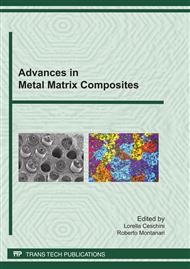[1]
F. Bonollo, L. Ceschini, G. L. Garagnani, G. Palombarini, A. Zambon: Mater. Sci. and Techn. Vol. 10, Issue 6 (1994), p.481.
Google Scholar
[2]
L. Ceschini, C. Bosi, A. Casagrande. G. L. Garagnani: Wear Vol. 251 (2001), p.1377.
Google Scholar
[3]
L. Ceschini, A. Morri, G. Sambogna, M.C. Breslin, M. Fuller: Int. J. of Mat. & Prod. Techn., Vol. 17, Issue 3/4 (2002), p.165.
Google Scholar
[4]
R. L. Deuis, C. Subramanian, J. M. Yellup: Wear Vol. 201 (1996), p.132.
Google Scholar
[5]
R. L. Deuis, C. Subramanian, J. M. Yellup: Comp. Sci. and Techn., Vol. 57 (1997), p.415.
Google Scholar
[6]
M. Godet: Wear Vol. 136 (1990), p.29.
Google Scholar
[7]
A. L. Yerokhin, X. Nie, A. Leyland, A. Matthews, S. J. Dowey: Surf. and Coat. Techn. Vol. 122 (1999), p.73.
Google Scholar
[8]
A. L. Yerokhin, A. Shatrov, V. Samsonov, P. Shashkov, A. Pilkington, A. Leyland, A. Matthews: Surf. and Coat. Techn. Vol. 199, Issue 2-3 (2005), p.150.
DOI: 10.1016/j.surfcoat.2004.10.147
Google Scholar
[9]
L.O. Snizhko, A.L. Yerokhin, A. Pilkington, N.L. Gurevina, D.O. Misnyankin, A. Leyland, A. Matthews: Electrochimica Acta Vol. 49 (2004), p. (2085).
DOI: 10.1016/j.electacta.2003.11.027
Google Scholar
[10]
E. Matykina, R. Arrabal, P. Skeldon, G. E. Thompson: Surf. Interface Anal. Vol. (2010), p.221.
Google Scholar
[11]
R.O. Hussein, X. Nie, D.O. Northwood, A. Yerokhin, A. Matthews: J. Phys. D: Appl. Phys. Vol. 43 (2010), p.1.
Google Scholar
[12]
J. A. Curran, T. W. Clyne: Surf. and Coat. Techn. Vol. 199 (2005), p.168.
Google Scholar
[13]
J.A. Curran, T.W. Clyne: Surf. and Coat. Techn. Vol. 199 (2005), p.177.
Google Scholar
[14]
A.L. Yerokhin, X. Nie, A. Leyland, A. Matthews: Surf. and Coat. Techn. Vol. 130 (2000) p.195.
Google Scholar
[15]
A.L. Yerokhin, A. Leyland, A. Matthews: Appl. Surf. Sci. Vol. 200 (2002), p.172.
Google Scholar
[16]
L. Ceschini, E. Lanzoni, C. Martini, D. Prandstraller, G. Sambogna: Wear Vol. 264 (2008) p.86.
DOI: 10.1016/j.wear.2007.01.045
Google Scholar
[17]
R. Arrabal, E. Matykina, T. Hashimoto, P. Skeldon, G.E. Thompson: Surf. and Coat. Techn. Vol. 203 (2009), p.2207.
Google Scholar
[18]
S.V. Gnedenkov, O.A. Khrisanfova, A.G. Zavidnaya, S.L. Sinebryukhov, V.S. Egorkin, M.V. Nistratova, A. Yerokhin, A. Matthews: Surf. and Coat. Techn. Vol. 204 (2010), p.2316.
DOI: 10.1016/j.surfcoat.2009.12.024
Google Scholar
[19]
A. L. Yerokhin, L. O. Snizhko, N. L. Gurevina, A. Leyland, A. Pilkington, A. Matthews: J. Phys. D: Appl. Phys. Vol. 36 (2003), p.2110.
DOI: 10.1088/0022-3727/36/17/314
Google Scholar
[20]
M. Cartier, Handbook of Surface Treatments and Coatings (HEF Group, Professional Engineering Publishing, New York 2003).
Google Scholar
[21]
X. Nie, E.I. Meletis, J.C. Jiang, A. Leyland, A.L. Yerokhin: Surf. and Coat. Techn. Vol. 149 (2002), p.245.
Google Scholar
[22]
R.C. Barik, J.A. Wharton, R.J.K. Wood, K.R. Stokes, R.L. Jones: Surf. and Coat. Techn. Vol. 199 (2005), p.158.
Google Scholar
[23]
Y. Guan, Y. Xia, G. Li: Surf. and Coat. Techn. Vol. 202 (2008), p.4602.
Google Scholar
[24]
S. Cui, J. Han, Y. Du, W. Li: Surf. and Coat. Techn. Vol. 201 (2007), p.5306.
Google Scholar
[25]
J. Lee, S. Kang, J. Han: Wear Vol. 264 (2008), p.75.
Google Scholar
[26]
L. Ceschini, G. S. Dahen, G. L. Garagnani, C. Martini: Wear Vol. 216 (1998), p.229.
Google Scholar
[27]
W. C. Oliver, G. M. Pharr: J. Mat. Research Vol. 7 (1992), p.1564.
Google Scholar
[28]
L.E. Samuels, T.O. Mulhearn: J. of the Mech. and Phys. of Solids 5 (1957) 125-134.
Google Scholar
[29]
J.L. Sullivan, S.G. Hodgson: Wear Vol. 121 (1988), p.95.
Google Scholar
[30]
B. Venkataraman, G. Sundararajan: Wear Vol. 245 (2000), p.22.
Google Scholar
[31]
G. Straffelini: Attrito e usura. Metodologie di progettazione e controllo (Tecniche Nuove, Milano 2005).
Google Scholar
[32]
I. M. Hutchings: Tribology, Friction and Wear of Engineering Materials (Edward Arnold, UK 1992).
Google Scholar


